|
         
1.
TOPIC: O
Christmas tree.

2.
AGE: 3, 4 and 5 years.
3.
TIME: 50 minutes.
4.
AIMS
-
Objectives:
a.
Recognising the vocabulary about Christmas.
b.
Physical co-ordination.
c.
Understand globally the song.
d.
Name the basic vocabulary about Christmas.
-
Attitudes:
a.
Showing interest on the activities.
b.
Showing respect to the teacher and the other pupils.
-
Vocabulary:
Christmas tree, branches, and weather.
5.
DESCRIPTION: a traditional
Christmas song.
6.
MATERIALS: flashcards of the
vocabulary.
7.
IN CLASS:
-
First we must present the vocabulary with the flash cards and
asking them to repeat.
-
The next thing we can do is sing or play the song, the second
time we will help children
understand doing the actions while we sing the song. The next time we
will sing it again encouraging
the children to join in and do the actions.
| O
Christmas tree O christmas tree |
make
your arms into a triangle shape |
| how
lovely are your branches |
|
| O
Christmas tree O christmas tree |
make
your arms into a triangle shape |
| how
lovely are your branches |
|
| in
summer sun or winter snow, |
hold
hands above head with fingers open like sun's rays and then bring
them down, moving fingers like snow. |
| A
coat of green you always show. |
|
| O
Christmas tree O christmas tree |
make
your arms into a triangle shape |
| how
lovely are your branches |
|
8.
COMMENTS: we can repeat the song as
many times as necessary.
9.
VARIATIONS:
We can sing the song in groups.
10.
EVALUATION CRITERIA: We will
evaluate through the materials presented in class. We will expect them
to identify and name the objects of the vocabulary
presented and sing the song.
1.
TOPIC: Arts
and crafts1, a Christmas tree.

2.
AGE: 3, 4, 5 years.
3.
TIME: 25 minutes.
4.
AIMS:
-
Objectives:
a.
Following instructions.
b.
Eye-hand co-ordination.
-
Attitude:
a.
Showing respect for their partners.
b.
Showing interest in the activity.
c.
Showing interest in the new language.
-
Vocabulary: colours, tree, branches
and star.
5.
DESCRIPTION: the children
make a pretend tree.
6.
MATERIALS: Green card triangle,
bright papers, colours a paper star and glue.
7.
IN CLASS:
-
The
fist thing we will do is show them the green card triangle and ask them
what they think they are going to make (to create expectations).
-
If
they cannot guess then tell them they are going to make a Christmas tree.
-
Show
them the bright and coloured papers you have collected and get them to
say the colours they see on a tree. Stick decorations to your tree as
they tell you.
-
The
children now make a tree themselves.
-
The
last thing will be doing a star and sticking it on the top of each tree.
8.
COMMENTS: we will have to help the
little ones.
9.
VARIATION: if children are just
learning the colours and are not very confident at speaking, we will
have to convert it into a listening exercise by telling them which
colours to take from the pile of papers. Another variation can be
sticking on a wall a big green triangle, low enough for
the children to reach. All the children help to decorate the
class tree.
10.
EVALUATION CRITERIA: We will
evaluate through the materials presented in
class. We will expect them to identify and name the objects of
the vocabulary presented and to
follow instructions correctly.
1.
TOPIC: Arts
and crafts2, a Christmas tree.

2.
AGE: 3, 4 and 5 years.
3.
TIME: Two sessions.
4.
AIMS:
-
Objectives:
a.
Following instructions.
b.
Eye-hand co-ordination.
-
Vocabulary: colours, numbers, tree,
branches, star and Father Christmas.
-
Attitude:
a.
Showing respect for their partners.
b.
Showing interest in the activity and in the new language.
5.
DESCRIPTION: the children make a
big tree with their hands.
6.
MATERIALS: green paint, a
recipient with water, big white paper (with the shape of a
Christmas tree and numbers) photocopies of a star and Christmas balls
and colours.
7.
IN CLASS:
First
session:
-
We will show them the materials and introduce some vocabulary.
-
We will put on the wall the big white paper and tell them that we
will paint only there.
-
The
next thing we will do, is to show them the green paint and tell them
that they have to be careful with it. We will put a little bit in their
hands one at the time and they will stamp them following the
instructions of the teacher. We will say you are number one so you will
have to put your hands in the place were number one is written.
-
After
stamping their hands they will wash their hands in the recipient and dry
them up.
-
While
a pupil stamp the other can colour the star. They all colour the same
big star. They can also colour and decorate with the papers the face of
Father Christmas.
Second
session:
-
The
first thing will be revising the vocabulary presented.
-
The
next thing is colouring the Christmas balls.
-
After
colouring the balls we will stick the photos of the children of the
class in the balls.
-
Then
we will put the balls on the tree revising the colours pointing to the
balls.
-
After
doing the tree and the decoration we can sing a traditional Christmas
song.
8.
COMMENTS: we will have to help the
little ones and watch out for the paintings.
9.
VARIATION: we can let them stamp
freely on the shape. The song must be known.
10.
EVALUATION CRITERIA: We will
evaluate through the materials presented in class.
We will expect them to identify and name the objects of the
vocabulary presented and to
follow instructions correctly.
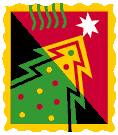
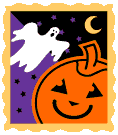
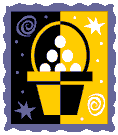
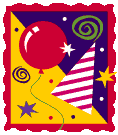
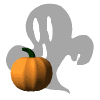
        
1.
TOPIC: Halloween.

2.
AGE: 3, 4, and 5 years.
3.
TIME: Two sessions.
4.
AIMS:
-
Objectives:
a.
Knowing some basic aspects of Halloween.
b.
Recognition of some basic vocabulary of Halloween
-
Attitudes:
a.
Showing interest on the activities.
b.
Being clean and respectful with the materials.
c.
Showing interest in other cultures and traditions.
-
Vocabulary: bats, star,
pumpkin, witch and broom.
5.
DESCRIPTION: sing a song of
Halloween.
6.
MATERIALS: we will need the puppet
we use in class or a doll, a little white bag with three pieces of black
paper, a big black bag, little stars, moons and bats, glue, a
broom and a pumpkin.
7.
IN CLASS:
-
First
the teacher talks about some aspects of Halloween in England.
-
The
next thing will be introducing a puppet saying that it is happy because
he is going to celebrate Halloween. He will ask for help to find a
disguise.
-
The
teacher will take out different elements from a bag and introduce the
vocabulary of the elements. At the same time the teacher will disguise
the puppet.
-
The
puppet will disguise of ghost with a white bag and three black circles
for eyes and the mouth.
-
The
teacher will put on a big, black bag where the pupils will stick stars,
moons and bats. In the head we can put a hat of witch and we take out a
broom.
-
We
now present the pumpkin.
-
The
last thing will be presenting a little song and sing it doing the
actions following the teacher.
-
After
singing the song, at the end of the class the teacher can give the
pupils some sweets as it is said
on the tradition.
8.
COMMENTS: if the pupils don't know
yet the colours the teacher doesn't need to insist
in them.
9.
VARIATIONS: the pupils can disguise the
puppet or the teacher can give them pictures
of stars, moons and bats and the pupils decorate and then stick them on
the black bag.
10.
SONG:
HALLOWEEN,
IT'S HALLOWEEN
I'M
A WITCH AND I AM HAPPY IN HALLOWEEN.
HALLOWEEN,
IT'S HALLOWEEN
I'M
A GOST AND I AM HAPPY IN HALLOWEEN.
HALLOWEEN,
IT'S HALLOWEEN
I'M
A BAT AND I AM HAPPY IN HALLOWEEN.
(Very
young learners. Vanessa R. and Sheila M. ward. Oxford University press.
1999)
11.
EVALUATION CRITERIA: We will evaluate
through the materials presented in class. We will expect them to
identify and name the objects of the vocabulary presented and to sing
the song.




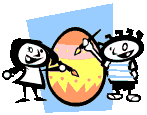      
1.
TOPIC: Easter,
egg painting.

2.
AGE: 3, 4 and 5 years.
3.
TIME: 25 minutes.
4.
AIMS:
-
Objectives:
a.
Following instructions.
b.
Eye-hand co-ordination.
-
Vocabulary: Colours they had learnt.
-
Attitudes:
a.
Showing interest in the cultural aspects of other countries.
b.
Showing interest in the new language.
5.
DESCRIPTION: Children decorate eggs.
6.
MATERIALS: One hard-boiled egg
or a paper one
per
child and one for the teacher, coloured crayons
or pencils.
7.
IN CLASS:
-
The
first thing we have to do is talking about the tradition of Easter.
-
Revise
colours by showing the colours and eliciting the names for them.
-
Show
the children how to decorate an egg.
-
Give
each child an egg and let them decorate it following instructions but
letting them do it as they like. For example paint with red.
-
To
deal with the tradition we can hide the eggs and let the children look
for them with clues like hot or cold (explaining to them or with
pictures of a sun and snow).
8.
COMMENTS: Parents will have to bring
the boiled eggs.
9.
VARIATION: dividing the class in
groups children have to say the colour that they are going to use. For
example the first group is given a card with a colour and another with a number. The
numbers will be the order of the group that will start and the card of the colour will be the one that they will have to paint. Instead
of using boiled eggs pupils can decorate a drawing of it
and after finding it they can use it as an easter card or to decorate
the class.
10.
EVALUATION CRITERIA: We will
evaluate through the materials presented in class.
We will expect them to identify and name the objects of the
vocabulary presented and
to follow instructions correctly.
1.
TOPIC: Easter
story.

2.
AGE: 3, 4 and 5 years.
3.
TIME: Two sessions.
4.
AIMS:
-
Objectives:
a.
Listening to a story.
b.
A global comprehension of the story.
c.
Revision of the names of animals.
-
Vocabulary: Names of animals they
know, king, I am a... and you are a...
-
Attitudes:
a.
Showing interest in the story.
b.
Showing respect when the teacher is speaking.
5.
DESCRIPTION: Listening to a
story.
6.
MATERIALS: Pictures or masks of the characters and a puppet for
the king.
7.
IN CLASS:
-
Tell
the children that in many English speaking countries the Easter Rabbit
takes chocolate eggs to the children. Ask children what a rabbit looks
like. To introduce the story, tell them that rabbits have not always
long ears and that you are going to tell them how they got long ears.
-
Tell
the story. Use mime to give some visual back-up to the words.
-
The
next part of the lesson will be doing masks of the characters of the
story. Each child will have to choose a character and they will paint
the pattern given.
-
After
doing the mask we can represent the story as many times as we want
because children love stories and they will like the idea of being the
characters.
8.
COMMENTS: The ears of the mask of
the rabbit can grow as the story says it. These
activities can be used in carnival as well. In the representation
the pupils will mime the
actions after the teacher.
9.
VARIATION: Children can do finger
puppets of the characters of the story.
10.
STORY: Why do rabbits
have long ears?
Once
upon a time the King of the Animals decided to give all the animals
names.
He
said, "you are a lion"
"You
are a monkey"
"You
are a crocodile"
"You
are a frog"
"You
are a tiger"
"You
are a hippo"
And
finally he said to the rabbit "you are a rabbit".
But
rabbits have terrible memories and rabbit could not remember his name.
"Oh
no! I can't remember my name".
So
he went to the king and said "I'm sorry. I can't remember my name".
"You are a rabbit", said the king. "Oh, thank you!"
said the rabbit. The rabbit went away, "I'm a rab-ra-r. Oh, no! I
can't remember my name."
So
the rabbit went to the king and said, "I'm sorry. I can't remember
my name".
"You
are a rabbit". Said the king. "Oh, thank you!" said the
rabbit and went away, I'm a rab-ra-r. Oh, no! I can't remember my name.
So the rabbit went to the king and said "I'm sorry. I can't
remember my name". The king was angry and he shook the rabbit by
the ears "you are a rabbit, rabbit, rabbit", said the king.
"Oh, yes. I'm a rabbit"
The
rabbit went away, I'm a rab-ra-r. Oh, no! I can't remember my name.
The
Rabbit went for a walk and he saw a (animal)
"What
is your name?" said the rabbit.
"My
name is (animal)"
The
rabbit said, "my names is rab-ra-r. Oh, no! I can't remember my
name. Goodbye!" Suddenly his ears grew just a little bit. And he
continued until he saw (animal)
"What
is your name?" said the rabbit.
"My
name is (animal)"
(Repeat
the black part with all the animals)
The
rabbit's ears were long and he suddenly remembered the king "my
name is rabbit. Hello (animal), my name is rabbit. Hello (animals)."
11.
EVALUATION CRITERIA: We will evaluate
through the materials presented in class.
We will expect them to identify and name the objects of the
vocabulary presented.




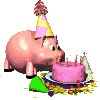
       
1.
TOPIC: Birthday
party.

2.
AGE: 3, 4 and 5 years.
3.
TIME: 35 minutes.
4.
AIMS:
-
Objectives:
a.
Count till the years of the children.
b.
Recognition of colours.
c.
Following instructions.
-
Vocabulary: Numbers, colours,
vocabulary related to birthdays (cake, candle,...)
-
Attitudes:
a.
Showing respect to all the pupils.
b.
Showing interest in the activity.
c.
Showing interest in the new language.
5.
DESCRIPTION: Painting and decorating
a cake.
6.
MATERIALS: Big papers, crayons,
scissors, newspaper, numbers of the age and glue.
7.
IN CLASS:
-
We
can celebrate the birthday party each month.
-
The
first thing we have to do is divide the class in groups, as many groups
as children
have their birthday in that month. We have to give a page of the
newspaper to each
group and giving the steps and doing a model the pupils have to do a
simple hat.
-
The second activity will be decorating the hat, they will do it
freely
but they
will have to
put in the hat the number of the age
(given by the teacher).
-
The next activity is painting a big birthday cake situated on a
wall
following the
instructions of the teacher.
-
They will colour the candles too in the colours that the teacher
says. After
painting the
cake and the candles, we will revise the colours all together,
we
can ask for the colour pointing,
asking
them to repeat, asking them to
stick a candle of a colour, asking them to look for a candle in the cake... it
depends on the age of the
pupils and the confidence they have in that learning.
-
The last part of the class will be singing all together
"Happy
Birthday" accompanying the song with mimic.
8.
COMMENTS: The number of candles will let us revise the numbers
that they know.
9.
VARIATION: We can
ask parents to bring a little cake and let them eat a little piece after singing.
10.
EVALUATION
CRITERIA: We will evaluate through the materials presented in class.
We will expect them to identify and name the objects of
the vocabulary presented.
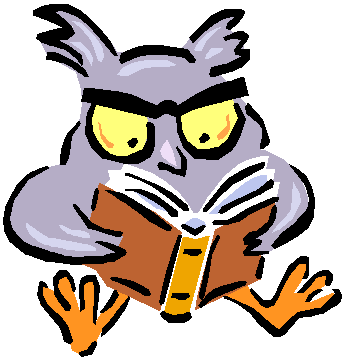
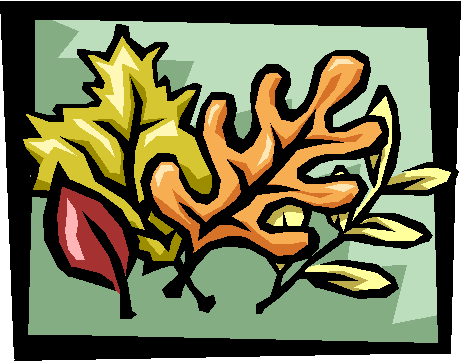
 MY
FAMILY MY
BODY ANIMALS
HOME
MY
FAMILY MY
BODY ANIMALS
HOME
|